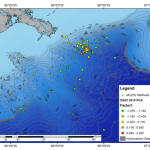Obama’s Pledge on the Environment
“We cannot afford more of the same timid politics when the future of our planet is at stake. Global warming is not a someday problem, it is now. We are already breaking records with the intensity of our storms, the number of forest fires, the periods of drought. By 2050 famine could force more than 250 million from their homes . . . . The polar ice caps are now melting faster than science had ever predicted. . . . This is not the future I want for my daughters. It’s not the future any of us want for our children. And if we act now and we act boldly, it doesn’t have to be.”

Barack Obama spoke these words addressing an audience in Portsmouth, New Hampshire in late 2007. He, with the notable exception of Al Gore, represented one of the most progressive presidential candidates on matters of environment protection, green energy, and climate change. The League of Conservation Voters gave Obama the highest lifetime rating of anyone ever running for president of the United States.
Vying for the White House, Barak Obama and Joe Biden’s environmental agenda (pdf) was both detailed and ambitious. The plan called for stricter policies, renewed commitments, and investment in research and infrastructure all while creating new jobs and technologies. As a candidate, he vowed to:
- reduce carbon emissions by 80% by 2050 with a market-based cap-and-trade system:
- invest in clean energy, including research, and create American jobs by doing so;
- establish policy and incentives to improve the energy efficiency of buildings, with the federal government itself setting an example;
- create a green job core;
- invest in a digital smart grid and more fuel efficient modes of transportation while making communities themselves generally more sustainable;
- make the United States a leader in combating climate change by re-engaging with the U.N. Framework on Climate Change, creating a new forum for the largest greenhouse gas emitters, sharing American technology with the developing world to fight climate change, confront deforestation, and promote carbon sequestration;
- renew our commitments to clean air and water through new policies and by restoring American lakes, rivers, and wetlands;
- and increase protection of National Parks and Forests, creating new protected areas, and incentivizing the protection of private lands.
Barack Obama’s environmental stance exemplified his overall platform of hope and change and it garnered my vote. However, politics often represents a journey of compromise and disappointment despite ideals and best efforts. After two years in office, what became of Barack Obama’s environmental pledge to the American public?
Quick Action Early On
Within a short few months, Obama seemed to exemplify a renewed commitment to the environment and reversal of Bush era politics. Needed policies, delayed during the Bush era, were quickly signed and put into effect. One of the best examples was the requirement for higher energy efficiency from appliances. On Inauguration Day, Obama blocked plans to reduce air quality standards and remove the gray wolf from the endangered species list.
Obama asked the EPA to reconsider granting California a waiver to impose their own stricter limits on carbon dioxide emissions from cars. Simultaneously, he signed a presidential memorandum to set new fuel efficiency standards from the current average of 27 mpg to 35 mpg by 2011. In February of 2009, the U.S. and Canada agreed to a joint initiative combating global warning. In March of 2009, when details of the new stimulus package surfaced, $59 billion in tax incentives and research funds of the $787 billion total stimulus package were earmarked for clean energy. This linking of the budget and environment is a welcome Obama trademark. Clearly, Obama had not faltered on his campaign pledges. But many worried that with Obama’s agenda tackling the “sacred cows” of health care reform, military involvement overseas, the joint problems of the budget, the national debt, and financial reform, that climate change would lose out.
Two Years Later
Unless you’ve lived in complete isolation without radio, internet, TV, or newspapers then you are fully aware that health care reform, foreign policy, and budget consumed Obama’s first two years. But did the environment lose out? Yes and No.
When the American Recovery and Reinvestment Act eventually did pass more than $80 billion was dedicated to the development of renewable/clean energy, smarter electrical grids, and fuel efficiency technologies all with the goal of producing green jobs. Obama also fulfilled his campaign promise of committing the Federal Government to lead by example promising a 28% reduction in greenhouse emissions by 2020. In May 2009, Obama announced fuel economy and gas emissions standards for cars and trucks including the first standards for previously ignored medium- and heavy-duty cars and trucks. A task force identified key barriers to making homes more energy efficient. The Recovery Through Retrofit program will seek to eliminate these barriers, chiefly the lack of straightforward information for consumers on their home’s energy use and how to improve it.
The Obama administration also worked toward protecting, conserving, and restoring U.S. lands. Obama in early 2009 signed the broad reaching Omnibus Public Land Management Act designating 2 million acres in 9 states as wilderness, creating new trails, renewing commitment to protection of historic battlefields and National Parks, protecting watersheds, cleaning up groundwater, and making efforts to revitalizing our fisheries. Obama also signed a presidential memorandum establishing the America’s Great Outdoors Initiative to support communities in conserving outdoor spaces and promoting public interest in the outdoors. To restore habitats, he established a group to coordinate and improve restoration of the Gulf of Mexico coastal regions, and outline near-term actions to restore the California Bay Delta and the Chesapeake Region. Obama also dedicated $475 million for Great Lakes restoration, the most invested into the lakes in two decades.
With regard to climate change, Obama hit some well-known stumbling blocks but managed some advancement. On one campaign promise, meager progress was made turning the U.S. into an international leader. In regards to the international community, the U.S. renewed interest in the Major Economies Forum; moved toward eliminating fossil fuel subsides; formed new partnerships with China, India, Mexico, and Canada; and begin phasing down HFCs. For the first time, the U.S. will catalogue greenhouse gas emission from large emissions sources. Thirteen federal agencies are now collaborating on the U.S. Global Change Research Program to reduce green gas emissions and grow a clean energy economy. Obama signed an executive order calling on a task force to develop within one year recommendations for adapting to climate change impacts.
But many herald the most important contribution of the Obama administration to be the American Clean Energy and Security Act.
In the most sweeping accomplishment – not just of 2009 but perhaps in a generation – the House passed the landmark American Clean Energy and Security Act in June by a vote of 219-212. This vote marked the first time that comprehensive global warming and clean energy legislation passed either chamber of Congress. The House-passed bill, while not perfect, would reduce global warming pollution by 17% by 2020 and 83% by 2050 and includes complementary clean energy measures to help meet those emissions reductions.
Obama’s Environmental Mistakes
However, Obama’s environmental legacy does contain some glaring omissions and quite frankly some major failings. Although early on Obama reversed many of Bush’s decisions, he could have also stopped several other controversial, late-term environmental regulations including revisions to the Endangered Species Act, movement to open up lands in the West for oil shale development, leases for oil/gas drilling near national parks, new offshore oil drilling, and mountain top coal mining. With regard to last of these, while the Memorandum of Understanding between key agencies seeks to strengthen oversight/regulation and minimize environmental impact from mountain top coal mining, it falls horrendously short of ending the destructive practice coal mining mountaintops. The Secretary of Agriculture allowed the clear-cutting of 381 acres of primary rainforest in Alaska’s Tongass National Forest. Under Obama, the EPA will clean up fewer Superfund sites than any other administration since 1991.
Many also viewed the Copenhagen Climate Summit as a failure. The U.S., despite Obama’s pledge for our new leadership role in international climate change plans, and negotiators failed to reach any binding contract to reduce greenhouse gases when the Kyoto Protocol expires in 2012. The resultant “meaningful agreement” adds a $1 trillion price tag to preventing increase in temperatures, provides no real mechanism to decrease global emissions, reduces emission cuts, and lacks any substance.
In a very surprising move, Obama unveiled plans for large swaths of the ocean to be drilled for oil and gas for the first time. Of course there is also the Obama administration’s response to the Gulf of Mexico BP oil spill. Obama’s own commission stated that the administration lagged in initial response, played down spill projections, overreacted, and injected politics into the situation. To that I would add, Obama also failed to sufficiently reprimand BP in both the short term and long term, capitalize on the opportunity of negative public sentiment to make gains in energy policy, continue to downplay the impact of the oil spill on Gulf ecosystems, and provide sufficient funds and support for independent scientific research into the environmental impact of the oil spill.
There is also the travesty of Obama’s treatment of the Endangered Species Act. Recently he denied Endangered Species Act protection to 251 species. Instead he placed them in long-term limbo on the “candidate” species list. So far Obama has designated only 51 species as endangered under the Act and is far below the annual averages of both Clinton and Bush.
Clearly not everything is sunshine and daisies.
Obama and the Oceans
Obama established the Interagency Task Force on Ocean Policy to develop recommendations for national policy. In July of this year, Obama signed an Executive Order establishing a National Policy for the Stewardship of the Ocean, Coasts, and Great Lakes that moved to strengthen ocean governance and coordination while establishing guidelines. Specifically the Order set U.S policy with regard to these ecosystems to:
- protect, maintain, and restore the health and biological diversity as well as improve resiliency;
- bolster conservation and sustainable use;
- use the best available science and knowledge to inform decisions;
- support sustainable, safe, secure, and productive access to and uses of ;
- respect and preserve our Nation’s maritime heritage;
- increase scientific understanding of these habitats and interconnections;
- improve our understanding and awareness of changing environmental conditions, trends, and their causes, and of human activities taking place;
- foster a public understanding of the value of these habitats and build a foundation for improved stewardship;
To accomplish and promote this policy the order calls for comprehensive increases and a collaborative framework for stewardship across government agencies and levels, for the U.S. to take an international leadership role, and for supporting stewardship in a fiscally responsible manner. More importantly it establishes the National Oceans Council composed of government officials tasked with the above-mentioned ordered agenda.
What is more obvious is what has not been done. Last year Obama’s NOAA Chief Lubchenco revealed there were no plans to consider new marine protected areas citing the lack of funds. Although commended by Ocean Conservancy for establishing a National System of MPA’s, Obama’s administration is simply coordinating efforts between existing MPA’s and agencies while not protecting new areas.
Hope and Change in the Next Two Years?
Clearly, there is room for improvement. The Obama administration has been consistently ineffective in communicating its progress on any issue to the public. I see this as largely responsible for the mid-term election results. Indeed, before writing this post I too was both unaware of and unconvinced by Obama’s contributions to environmental policy.
Obama’s accomplishments largely appear to lie in the creation of task forces, councils, and working groups. While I appreciate that he wants to proceed only after clearly examining an issue, his tenure so far with regard to the environment is characterized more by discussion than action. Hopefully, in the next two years we can move toward the latter.
The genius of Obama’s plan has been linking the budget and our economy to the development of clean energy innovations and reducing our energy demand. Creating green-collar jobs simultaneously addresses two major issues we face now—the recession and the environment. Let’s not forget it also makes sense for national security by reducing our reliance on foreign oil and possibly bank rolling the very causes we are against. Convincing the public that environmental initiatives are win-win is key. We need more of this forward thinking and it appears he is committed to this strategy.
My grade for Obama’s record is a B-. While I think he has made considerable improvements over prior presidents, I don’t feel he has gone far enough and his ocean policy is laughable at best. The latter is surprising given his Hawaiian island roots.
Of course I don’t expect major gains will be made in the next two years. The Obama environmental agenda is already under threat from incoming Republicans.
Republican leaders have begun gathering evidence for sweeping investigations of Barack Obama’s environmental agenda, from climate science to the BP oil spill… Republican leaders have also raised the possibility of disbanding the global warming committee in Congress.
My only hope is that Republicans read this letter.






You give President Obama a B- on the environment? Wow, Craig, I want to take a class that you teach…
Must be grading on a curve. But I think the Oil Spill knocked him down much like taking a midterm while hungover.
Here is my analysis:
http://www.southernfriedscience.com/?p=8700